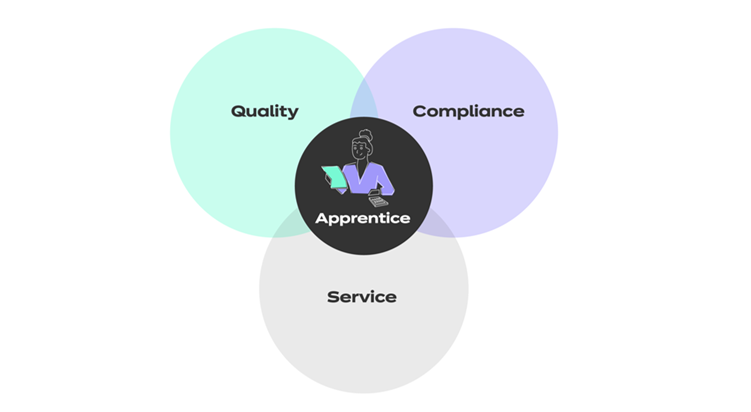Choosing an end-point assessment organisation (EPAO) for your provision isn’t easy – there are many things to consider when it comes to making your decision. That’s why I always recommend asking a key question to begin, which is ‘what is the EPAO’s motivation?’
I start with this question as your chosen EPAO should always have a quality-driven, ‘apprentice-centric’ approach. After all, what could be more important than this? You should feel confident that the EPAO will always keep your apprentice at the centre of all their decisions. And that's not just the apprentice on your programme today – but those who are in training across the country, and those who’ll be registered in the future.
Beyond this, you'll then consider what else could help with choosing an EPAO that offers the highest standards for your provision. To help answer this question, I wanted to take three legacy metrics that commonly inform this decision and ask if they remain the right things to look for – or, whether more fitting alternatives could be used to establish this.
The flaws in current EPAO selection metrics
1. The preference of providers could influence employers’ decisions of which EPAO to select. This is understandable – it's acknowledged that it can be burdensome for some providers to work across multiple EPAOs, each with differing contracts, systems and processes.
However, this could conceivably raise questions such as do employers understand what a good EPAO looks like, and are they best placed to influence this decision? Ultimately, they could possibly benefit from lower EPA fees, and there is little evidence to show that all employers understand what makes a good quality EPAO. Whilst this may lead to more streamlined administration for the provider, we could question if this is a truly apprentice-centric choice.
2. Judging the EPAO on overall and first-time achievement rates is another common metric used. Yet, we must remember that a successful outcome for an apprentice is the hallmark of the hard work and dedication from both apprentice and provider – not the EPAO.
As completely independent entities, end-point organisations do not have the ability to influence the outcome of the assessment and are there to make a final judgement against a set of criteria. In fact, where a low pass rate occurs, the mark of a good EPAO would be to support the provider with their concerns as opposed to this being a reflection of their quality of service. Is this metric therefore accurate?
3. The cost of EPA per apprentice is another big factor, and probably the largest when choosing an EPAO. We know the fee for EPA is up to the maximum of 20% of the funding band of each apprenticeship standard.
Currently, the actual fees vary across EPAOs, mostly ranging between 8.5% and 20%. Many standards with high apprentice volumes attract a larger volume of EPAOs on the register which has, understandably, created a competitive marketplace and is driving down the EPA fee. But could this cost-cutting also be driving down the quality of the EPA provision?
Proposing a stronger framework
It seems the current, most popular methods of EPAO selection being used are somewhat flawed and do not fully take into account the true expertise and excellence of an end-point organisation. So, how could we better approach the EPAO selection process?
For a good sense of how to measure the standard of an EPAO, I’d suggest looking at three new focus areas: quality, compliance and overall service.
Where the current methods of provider preference, success rates and fees can change and fluctuate, these suggested metrics should be firmly rooted in helping you to achieve apprentice-centric success. Let’s look a little more closely into these three metrics and how they can be measured.

Diagram showing an apprentice-centric framework
1. Quality strategies that are robust, reviewed regularly and have a clear outline of systems, policies and procedures to protect the outcomes of apprentices should be in place – and it should not be assumed that all EPAOs have these.
Some of the minimum expectations you should expect within a good quality EPAO include a sturdy internal quality assurance (IQA) process, thorough assessor training, regular standardisation, competent independent assessors and the provision of access to EQA feedback. Are these elements regularly considered as part of the EPAO selection process?
2. Compliance is critical, and if an EPAO is not fully compliant, you need to know what the outcomes are for your business and importantly, your apprentices. You should always be confident that answers to questions pertaining to meeting regulatory requirements are met with stringent measures and full assurance.
Does your EPAO meet the full conditions for being on the register of end-point assessment organisations? Do they meet all requirements of the assessment plan? Having confidence that an EPAO maintains compliance and is not willing to compromise the apprentice outcomes should be a high priority when selecting an EPAO.
3. Service expectations should always meet the requirements of all stakeholders. Your apprentices work hard to gain the knowledge, skills and behaviours as set out within the assessment plan of their chosen apprenticeships, so you should be able to agree a set of service level agreements with an EPAO that meet your needs.
This should include accessible support, an EPA fee agreement, and transparency – there should be no hidden fees, timescales or any concerns that you’re not aware of. It may also be appropriate to understand how the EPA fee has been calculated, as the way the fees have been decided on may provide an indication of the type of organisation you’ll be working with. Does this align with your own company values?
Selecting an apprentice-centric service
To find an end-point assessment organisation based on apprentice success rates, provider preference or EPA fees has the potential to misguide providers and employers into choosing a substandard EPA service. These metrics don’t seem to capture the benefits of each EPAO or demonstrate the compliance that should be maintained in EPA. Most importantly, they do not provide evidence of an ‘apprentice-centric’ service.
Whilst I don’t have all the answers, I do hope that the questions and suggestions that I’ve posed will provide food for thought for those who are considering switching EPAO, as well as helping to challenge the way that EPAOs are currently being selected.
By looking beyond fees and success rates and ensuring your morals are being reflected within your decision, you’re guaranteed to find an EPAO that is truly ‘apprentice-centric’, and therefore the best fit for you and your apprentices.
For advice or guidance when it comes to selecting an EPAO to meet your needs, you can get in touch with our EPA Relationship team.






